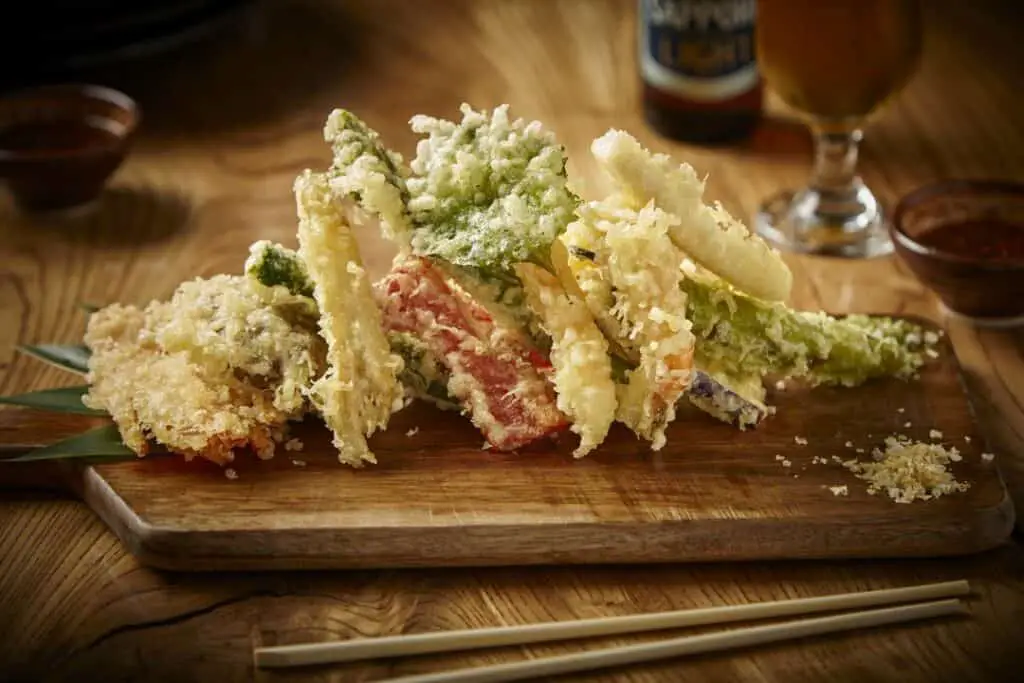There’s a lot more to Japanese food than just sushi. For example, tempura is a classic Japanese dish that consists of fried vegetables or seafood in a light batter. A lot of our readers ask us whether or not this airy and delicious recipe is gluten-free.
So is tempura gluten free?
Tempura is not gluten free. Tempura batter is traditionally made with wheat flour, which contains gluten. There are some recipes for gluten free tempura batter, but these are not traditional and may not taste the same as the real thing. If you’re concerned about gluten, it’s best to avoid tempura altogether.


It is possible to manipulate certain flours or starches to create a dough to be able to fry and achieve a crunchy layer like tempura.
It is possible that in your favorite restaurant they will not make you a special dough and if they do, it is most likely that they fry it in the same oil they use to make tempura. You would finally be consuming food with gluten.
Is Tempura Gluten-Free?
Due to the ingredients used to make Tempura in most traditional Japanese recipes, it is sadly not gluten-free. This is mainly due to the inclusion of starch and wheat flour, which add gluten to the recipe and make it either irritant or downright dangerous for certain individuals to consume.
However, if you love tempura and you can’t get enough of it, there are a few ways to ensure that it plays nicely with your system.
Let’s explore how you can make a gluten-free tempura so that you can keep loving this lightly fried Japanese delicacy.
Does Tempura Have Gluten?
Gluten, by definition, is wheat, rye or barley protein. Gluten enables foods containing these products to maintain their form — in effect, gluten acts like a “glue.”
Tempura cooking involves flour in the battering process and the flour contains gluten. Home cooks sometimes use panko breadcrumbs for a crispier coating, particularly for prawns, and this option also contains gluten.
It is worth mentioning, as well, that tempura is fried in a common oil vat in successive batches. Shards of cooked batter float in the oil, although they are typically removed quickly to prevent burning (and they are often added to other dishes as a specialty topping).
However, the fact that tempura has been boiled in the oil means that gluten will be present, even if the cooked tempura pieces and batter shards have already been removed.
There are alternatives to gluten flours for those determined to find a way to enjoy tempura while maintaining a gluten-free diet. The following flours do not contain gluten and can be used for a deep-frying batter:
- Cornstarch
- Potato flour
- Brown rice flour
- Tapioca starch
- Cassava flour

What about the seafood (prawns, shrimp) and vegetables (sweet potatoes, beans, carrots, mushrooms, etc.) that form the core of a tempura entrée? Fortunately, none of these items have gluten. And plain rice doesn’t contain gluten and is often served with tempura dishes like “tendon.” The sweet sauce that accompanies tempura is likely gluten-free as well if it was thickened with cornstarch.
An interesting often overlooked fact is that soy sauce often has gluten-products added during processing and should be avoided unless it is specifically described as being without wheat content. Also, sushi rice often has malt vinegar in it, which also contains gluten.
Why is Gluten a Concern?
Many people have gluten sensitivities, some on the mild end of the spectrum and some with life-altering consequences. Let’s look at the common diagnoses that result in instructions to adhere to a gluten-free diet:
| Condition | Symptoms |
| Celiac Disease | Chronic diarrhea, abdominal distention, appetite loss, failure to thrive |
| Non-celiac Gluten Sensitivity | Gastrointestinal problems, neurological disorders, fibromyalgia, dermatitis |
| Gluten Ataxia | Auto-immune disease, neuron expiration, intestinal damage |
| Dermatitis Herpetiformis | Skin inflammation, chronic blistering, auto-immune conditions |
| Wheat Allergy | Mouth/throat problems, skin irritation, nasal congestion |
Avoiding glutens is an incredibly restrictive diet in our culture. Many foods contain “hidden” sources of gluten that are not immediately obvious. Careful meal planning, including purchasing and cooking techniques, as well as extreme caution when eating out, are required.
How to Make Gluten Free Tempura
If you have Celiac disease, you may not be able to have a delicious tempura at your favorite restaurant.
However, you can enjoy it in your own home. There are some techniques that will allow you to make a gluten-free tempura. It is made with few ingredients that you surely have available.
Gluten-free tempura dough is made with rice flour, egg, and water. Unlike wheat flour, rice flour produces a finer dough. To thicken the dough you can add potato starch or cornstarch. You can add the starch or not, that will be your preference.

It is possible that the taste or the texture are like a traditional tempura but in combination with the food you choose you will get a very similar flavor. Whether you choose veggies or shrimp or chicken, be sure to coat them well with your gluten-free batter.
Make sure that the temperature of the oil is between 340 and 350ºF (170-180º) everything will depend on the cooking time that the food made in tempura requires. Frying at high heat will cause the topping to cook very quickly and the inside may still be raw.
The key to this technique as in tempura is to control the temperature of the oil. It is highly recommended to have a kitchen thermometer so that you have a good result in your tempura. It is also very important that you do not overload the pot with your ingredients. Be patient and fry your food little by little.
One recommendation is that before adding new ingredients to the pan, remove the leftover tempura from the previous batch. This will prevent the cooked tempura from sticking already burned to the new ingredients and giving your tempura a bad taste.
Remember that a good dish is adorned with a delicious accompaniment. As with gluten-containing tempura, pair your gluten-free tempura with a little soy sauce. Usually, soy sauce is made with wheat, therefore you must add a soy sauce without gluten in its components.
Fortunately, there are several products on the market in their gluten-free version. The good news is that you don’t have to make it, you just have to look for this version in the supermarket or a store of oriental products. And now, enjoy!
Vegan Gluten-Free Tempura

Some people not only avoid the consumption of gluten but also try not to consume products derived from animals. Today there are various recipes for conventional meals in their vegan version. One of those foods is tempura.
To make your tempura dough vegan and gluten-free, simply substitute the egg. You can continue using the rice flour or even use chickpea flour. Simply mix baking powder, the flour of your choice, and some mineralized water.
Mix all ingredients well. Choose your favorite vegetables and dip them in the mixture you just made. The technique is the same. Make sure to fry the vegetables on both sides until they are crisp and cooked through. 1 or 2 minutes per side will be enough to obtain a golden color.
Serve immediately and accompany your tempura with your favorite sauce.
Is Tempura Vegetarian and Vegan Friendly?

Often, there is confusion between gluten avoidance and vegetarian/vegan lifestyles. Although there is a cross-over between the permitted dietary choices for both groups, gluten-free diets are frequently a medical prescription rather than simply a choice for a healthy diet.
Given that we know tempura is not easily enjoyed by those on a gluten-free diet, are those avoiding meat and animal products able to partake?
There are some obvious no-no’s for strict vegetarians and vegans. Shrimp and prawns are shellfish animals and their meat is considered non-vegetarian. Tempura batter ingredients may contain animal products as well. Strict vegetarians will also be concerned about the oil in the vat used for batch frying, as meat product cross-contamination will occur.
Avoiding Gluten in Japanese Cooking
A gluten-free diet requires careful attention and, if one isn’t familiar with the particular preparation and cooking techniques from another region of the globe, the challenges can be immense.
It is wise to study the available lists of foods containing gluten, including foods with “hidden” sources of gluten, as well as preparing some straightforward questions which can be asked of restaurant chefs when you are eating out. Fortunately, sushi and sashimi (using real seafood, not imitation products) are often available in a gluten-free variety that avoids problematic rice vinegar. However, great care is still required.
Knowing the ingredients in one’s foods is important for all of us, but particularly for those requiring a gluten-free diet. It seems clear that tempura should be firmly placed in the “no go” category for people with dietary restrictions which force them to avoid all gluten.
Gluten-Free Accompaniments
There are several options such as gluten-free soy sauce or mustard sauce. There are even recipes to create a sweet sauce and enjoy it with your gluten-free tempura.
So now you know, there are several options you can choose from to make your own gluten-free or even vegan tempura. Whenever you have a craving for fried food, you can easily find the necessary ingredients at home to eat a delicious gluten-free tempura.